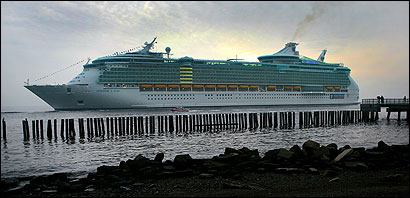 By David Abel | Globe Staff | 5/20/2006
By David Abel | Globe Staff | 5/20/2006As he nudged the throttle, guiding the enormous ship through a final, potentially perilous turn, the captain heard a thundering sound that shuddered the bridge's flat-panel screens and other high-tech gauges.
He thought he made a bad mistake.
Just after dawn yesterday, through a thick fog over Boston's inner harbor, Bill Wright saw he hadn't hit one of the comparatively pint-size boats cruising nearby. The loud sound came from above, and he watched as a US Airways jet swooped just over the 208-foot-tall ship on its way to Logan International Airport.
It was a startling welcome to Boston for the Freedom of the Seas, the world's largest passenger liner and one of the biggest boats ever to enter the harbor.
"It's unnerving to hear strange noises," said Wright, the Finnish-built ship's US captain. "I thought my hand hit something or that it was one of my thrusters."
For all its satellite-guided navigation gadgetry, the $800 million ship -- which is 300 feet longer than the John Hancock Tower -- is tall requires careful human oversight each time it comes to port, particularly in the tight spaces and high traffic of somewhere like Boston Harbor.
The potential dangers and the trickiness of handling such massive ships -- the Freedom of the Seas weighs about 160,000 gross tons (nearly 10,000 more than the Queen Mary 2, previously the world's largest passenger ship) -- recently prompted Massachusetts lawmakers to propose legislation requiring docking masters, or specially trained tugboat captains, aboard all large ships entering the harbor.
State and federal laws already require Coast Guard-licensed harbor pilots to board at sea all ships weighing 350 gross tons or more and bring them to port.
Which is why at 5 a.m. yesterday, Chris Hoyt sped some 6 miles out to sea on a 53-foot twin-diesel engine pilot boat. By luck of the draw, it was the veteran 48-year-old pilot's job to guide the mammoth cruise ship through the harbor's shoals and fast-moving currents.
"They bring me in for all the tough jobs," joked Hoyt, one of the harbor's 10 pilots, before his relatively tiny boat pulled alongside and he climbed a rope ladder onto the moving ship.
It took a five-minute walk through the 1,111-foot-long ship and an elevator ride up its 15 stories before Hoyt and Scott MacNeil, an apprentice pilot, reached the sprawling, glass-covered bridge. There, they took over the ship from Wright and began issuing course headings and other commands to a Filipino quartermaster, a Finnish first mate, and others on the crew, which totals 1,400 people from more than 65 countries.
Among the gleaming electronics on the bridge, a satellite image showed the ship moving at 6 knots through the harbor's buoys. With the captain gazing out over a wall of fog from a raised leather chair, Hoyt directed the quartermaster to head between Deer and Spectacle islands, where two small Coast Guard ships joined the Freedom of the Seas and began escorting it into the inner harbor.
"New ships can be a headache, because you don't know how they'll react," said Hoyt, adding that the liner's huge surface area exposes the ship to strong winds. "And you have to take large ships in very slowly. The worst thing is going too fast, because they don't stop very quickly."
As the Freedom passed an oil tanker and approached the inner harbor, MacNeil called the control tower at Logan to alert planes that the ship would soon be crossing through their landing path. When a ship taller than 175 feet is crossing through the inner harbor, Logan officials don't allow planes to land on Runway 4R using instruments alone.
The stop in Boston, where several thousand people in the travel industry came to see the boat yesterday, is the latest leg of the Freedom's maiden journey, a publicity tour wending from its construction site in Finland last month through various European ports to New York. The lavishly appointed ship, which features a casino, discos, pools, restaurants, arcades, even an ice skating rink, leaves Boston Monday for Miami, where it will be based for cruises in the western Caribbean.
Seven-day voyages range in price from $1,900 for a couple in an interior room during low season to nearly $2,500 for a same-sized cabin with a balcony during high season, said Tracy Quan, a spokeswoman for Royal Caribbean International, which owns the ship.
The presidential family suite, which sleeps 14, costs $22,000 during peak season, she said.
Shortly before the jets started whooshing overhead, the captain took control of the ship’s main engines, which rotate 360 degrees and function as a rudder. He steered the ship past Castle Island, and as it approached Conley Terminal, he maneuvered the engines to make the equivalent of a sharp port turn.
At about 7 a.m., with a heavy rain falling, the 127-foot-wide Freedom turned into the 600-foot-wide channel of the Black Falcon Cruise Terminal. It took a tense hour for the ship to come to a complete stop and several vans to help winch its 12 mooring lines to the old pier.
As a greeting, a fireboat pulled in front and shot its water cannons into the air.
In the distance, all that could be seen was fog, smokestacks, and the old, dilapidated pier.
"The Eagle has landed," Wright said.
David Abel can be reached at dabel@globe.com. Follow him on Twitter @davabel.
Copyright, The Boston Globe

